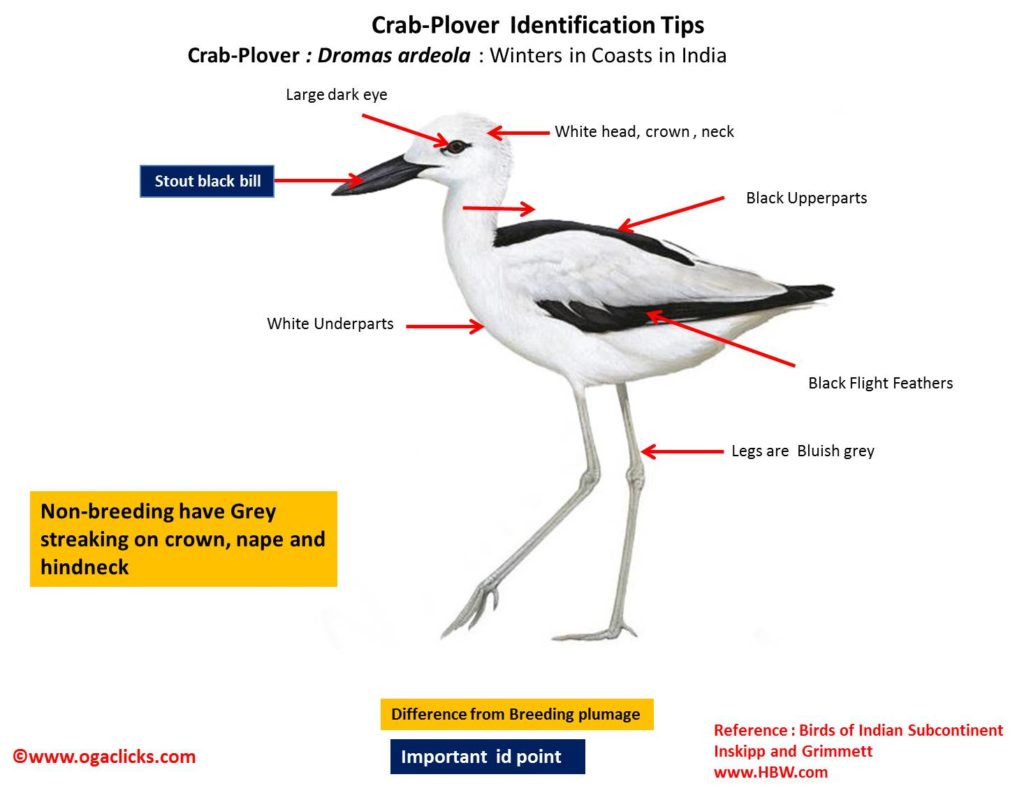
Crab Plover Dromas ardeola
Etymology:
- Dromas : Greek word for Running
- Ardeola : Latin word for Little heron
Vernacular Names: Guj: Shankhlo, Mal: Njandunni, Nicobar: Cummermelmova, Mald: Eshunga, Tayrawa, Hindi: Karka Plover, Mar: Chimborikhau
Distribution in India: Winter visitor in Gujarat and peninsular coast of India.
Description: Size of 38-41 cm, wt. of 230–325 g; wingspan of 66–78 cm. It is a black-and-white wader, with stout black bill and long bluish-grey legs. The Plumage is white apart from black back, flight-feathers, primaries, and primary and greater coverts. The tail is greyish. It has large dark eyes. Both the sexes are similar, but male larger than female. Non-breeding bird acquires grey streaking on crown, nape and hindneck. It is found in sandy coastlines and islands, intertidal sandflats and mudflats, estuaries, lagoons and exposed coral reefs. It is found also on rocky shorelines. The juvenile lacks distinctive adult pattern, which is replaced by grey-brown wing-coverts, blotchy black-brown crown and hindneck, silvery grey mantle and browner tail. The immature (second-year) plumage is intermediate between adult and juvenile, but lack of contrast in upperparts and pure white upperwing-coverts, and grey-streaked head and hindneck differ from adult, while blackish-grey back contrasts with retained pale grey scapulars and upperwing-coverts of juvenile plumage.
Habitat:
It is found in sandy coastlines and islands, intertidal sandflats and mudflats, estuaries, lagoons and exposed coral reefs.
Food habits: It eats mainly crabs , espl during breeding season. It also eats other crustaceans, small bivalve molluscs, marine worms and other inter tidal invertebrates. Fish may also occasionally be fed to young. It is most active at dusk and at night. It feeds by picking and probing and usually slow stalking, but sit-and-wait tactic also observed. Sometimes it runs very fast, or appears to dance around potential crab prey, but these movements are interspersed by frequent pauses. The crabs are stabbed with open bill, then crushed and eaten. “Scopate tomia”, a brush-like ridge on the cutting edges of the mandibles facilitate their ability to consume such prey. The bill is cleaned frequently, especially after swallowing food item. Occasionally steals suitable prey from other shorebirds and other crab plovers.
Breeding Habits: They breed in Apr–Jul in Persian Gulf, UAE, Yemen and Somalia. They are monogamous, with rather elaborate courtship display involving much vocalizing, at least in environs of colony. They breeds on sandy coral islands. They breed colonially in burrows set close together, forming honeycomb effect in sandy areas. Colonies often sited close to productive feeding areas. The colony is usually sited in similar area each year, although sometimes claimed that same pair may reuse its own burrow in following season, and may use comparatively little of the available, suitable substrate.. Tunnel may continue to be lengthened after egg laying. It lays one egg. Theincubation period is 32–33 days. The hatching happens synchronous across colony. The chicks arenidifugous, fed by both parents in nest chamber; when older, fed at mouth of burrow. The fledglingsare partially dependent on parents for several months.